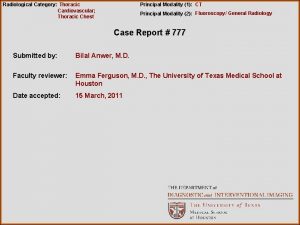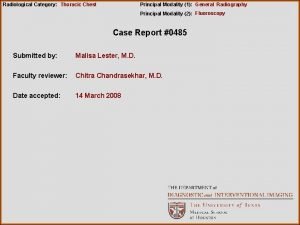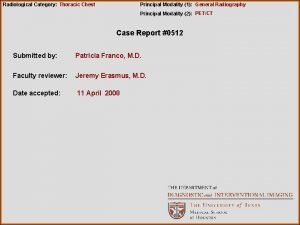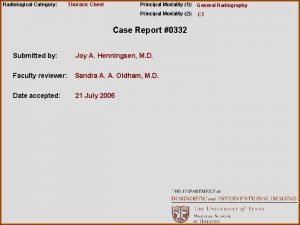Radiological Category Thoracic Chest Principal Modality 1 General










- Slides: 10

Radiological Category: Thoracic Chest Principal Modality (1): General Radiography Principal Modality (2): CT Case Report #0118 Submitted by: Scott Reabe, M. D. Faculty reviewer: Sandra A. A. Oldham, M. D Date accepted: 15 March 2004

Case History 56 y. o. female is transferred from outside institution after cardiopulmary arrest while undergoing a routine Dobutamine stress test. PMH significant for HTN, CAD, COPD and smoking. No history of malignancy. Initial portable ICU CXR is obtained. Five days later, a chest CT is obtained for further evaluation.

Radiological Presentations

Radiological Presentations

Radiological Presentations

Test Your Diagnosis Which one of the following is your choice for the appropriate diagnosis? After your selection, go to next page. • Pnuemonia. • Central obstruction; likely CA • Loculated pleural effusion or plueral thickening • Metastatic disease • Primary lung CA • Mucous plug • Atelectasis

Findings and Differentials Findings: CXR: Dense opacification of the upper left hemithorax with a relatively smooth inferior border in a S-shape. Prominence of left hilum. No other lung nodules or plueral effusions are seen. CT: (five days later) Left hilar mass with compression of left pulmonary artery and left upper lobe bronchus. Some left upper lobe collapse persists, but is improved (not shown). Differentials: • Primary lung CA with central obstruction or metastatic disease • Infectious etiology with large left hilar nodes

Discussion • This is an example of the “Golden-S Sign”. • The Golden-S sign is seen when there is atelectasis (or obstructive pneumonia) secondary to a central hilar mass. Originally, it was described with right upper lobe involvement, but now may be used in reference to any lobe. • When the left upper lobe is involved, there may be other signs of collapse such as the Silhouette sign (the atelectatic lobe obliterates the left cardiac border in frontal projection) or the Luftsichel sign (also air-crescent sign; when the overinflated left lower lobe is seen as a hyperlucency over the aortic arch in the frontal projection). • When atelectasis or obstructive pneumonia is associated with a hilar mass, cancer must be suspected. The most common types to present this way are squamous cell and small cell carcinoma. • Unilateral hilar lymphadenopathy is most often associated with small cell carcinoma

Discussion • Other considerations include: Sarcoid Foreign body Other malignancies, including metastatic disease Lymphoma Stricture TB or Histoplasmosis Mc. Loud, T. Thoracic Radiology, The Requisites. Mosby, 1998. Pgs. 37 -40. Muller, N. , et al. Radiologic Diagnosis of Diseases of the Chest. W. B. Saunders Company, 2001. Pgs. 103 -107, 212 -215.

Diagnosis Squamous Cell Carcinoma with partially obstructing hilar mass.
 Erate category 2 eligible equipment
Erate category 2 eligible equipment National radiological emergency preparedness conference
National radiological emergency preparedness conference Radiological dispersal device
Radiological dispersal device Tennessee division of radiological health
Tennessee division of radiological health Center for devices and radiological health
Center for devices and radiological health Sensory modality examples
Sensory modality examples Sodality vs modality
Sodality vs modality Deontic modality
Deontic modality Cardinality and modality
Cardinality and modality Cardinality and modality
Cardinality and modality Modality erd
Modality erd



















